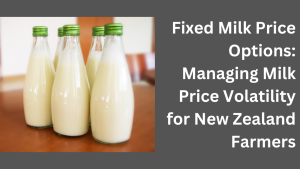
Payout volatility has long been challenging for New Zealand dairy farmers, impacting financial stability and cash flow management. With fluctuating global dairy prices and economic uncertainty, it’s crucial for farmers to explore risk management strategies that can provide greater certainty over their milk income. One such strategy is milk price hedging, which includes options like fixed milk price (FMP) and futures contracts.
What is Milk Price Hedging?
Milk price hedging is a risk management tool that allows farmers to lock in a set price for a portion of their milk production. This helps mitigate the financial impact of market fluctuations. By securing a portion of their income at a guaranteed price, farmers can plan better for the season ahead.
Fixed Milk Price (FMP) – How Does it Work?
Fonterra and Open Country, offer fixed milk price options. This allows farmers to apply for a set milk price for a portion of their production, ensuring a guaranteed payout for a part of your production.
Fonterra’s Fixed Milk Price (FMP) Programme
Fonterra provides ten monthly opportunities for farmers to apply for a Fixed Milk Price from March to December. The fixed rate can secure up to 50% of a farmer’s estimated seasonal production.
- If the Fixed Milk Price exceeds the Farmgate Milk Price, the difference is paid as a top-up in the September retro payment.
- If the Fixed Milk Price is below the Farmgate Milk Price, payments stop once the Advance Rate reaches the fixed price, meaning farmers won’t receive further payments for that fixed quantity.
Open Country’s Fixed Price Option
Open Country Dairy offers a similar scheme, allowing farmers to lock in up to 60% of their seasonal production. However, their payment structure differs, with farmers receiving the cash benefit earlier.
New Price Risk Management Options from Fonterra
From June 2025, Fonterra is introducing three new Price Risk Management Services, giving farmers even more flexibility:
1. Lock in a Fixed Milk Price for an Additional Season—Secure a set price for two seasons, increasing-price certainty over the long term.
2. Lock in a Minimum Milk Price (Floor Price) – Protect against price drops while still benefiting from any market price increases.
3. Lock in a Minimum and Maximum Milk Price (Price Band) – Ensure stability by setting both a minimum (floor) and maximum (cap) price.
You will be able to combine these tools for up to 50% of their estimated production for the season. These services are designed to offer greater budgeting certainty, helping farmers plan their financial future with more confidence.
Milk Futures Contracts – An Alternative Option
For those looking for more advanced price risk management, milk price futures contracts through the NZX (New Zealand Exchange) are another option. Farmers can:
- Purchase a futures contract at a set price per kg of milk solids (e.g., $8.00 per KgMS).
- Trade in bundles of 6,000 KgMS per contract through an NZX-listed broker.
- Deposit margin funds in an account, which fluctuates based on market changes.
Understanding Put Options in Milk Price Hedging
Beyond fixed milk price contracts and futures, put options are valuable risk management tools. A put option grants the holder the right, but not the obligation, to sell an underlying asset at a predetermined price (strike price) on or before a specified date. For dairy farmers, this means securing a minimum milk price, offering protection against potential price declines while retaining the ability to benefit from price increases.
How Put Options Work:
- Purchasing a Put Option: A farmer buys a put option with a strike price reflecting the minimum acceptable milk price.
- Scenario 1 – Market Price Falls Below Strike Price: If the market price drops below the strike price, the farmer can sell the milk at the higher strike price, thereby minimizing losses.
- Scenario 2 – Market Price Rises Above Strike Price: If the market price rises above the strike price, the farmer can let the option expire and sell at the prevailing higher market price, benefiting from the increase.
This strategy offers a safety net against adverse price movements while allowing participation in favourable market conditions. The New Zealand Exchange (NZX) provides educational resources to help farmers effectively understand and utilize these options.
Benefits of Hedging Milk Prices
- Financial Stability – Reduces the impact of price fluctuations on farm income.
- Cash Flow Certainty – Helps with financial planning and short-term bank funding.
- Better Budgeting & Forecasting – Ensures more predictable income for farm operations.
- Risk Mitigation – Protects against sudden price drops.
Considerations and Challenges
- Opportunity Cost – If milk prices rise above the fixed price, farmers miss out on potential extra income.
- Complexity – Understanding hedging tools can be challenging; professional advice is recommended.
- Costs – Transaction fees and contract terms may apply.
- Commitment & Flexibility – Some contracts require set volumes to be delivered.
Is a Fixed Milk Price Right for You?
Every farm business is unique, so milk price hedging isn’t a one-size-fits-all solution. Before committing, it’s essential to weigh the potential benefits, risks, and financial goals.
At CMK Accountants, we help farmers like you navigate these financial decisions and ensure their risk management strategy aligns with their long-term business plans. Contact our team today if you’d like to discuss how Fixed Milk Price options could work for your farm.


